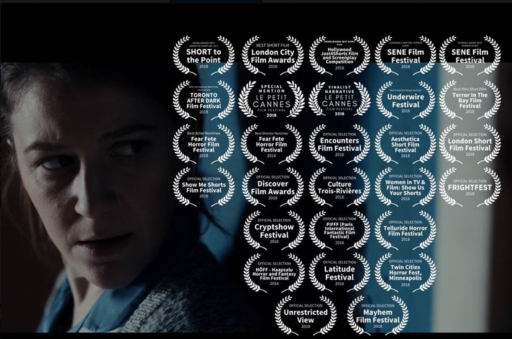As concern about the environment grows, so does eco-messaging in popular media. In recent years, we have seen an increasing number of documentary and fiction films dealing with themes of climate change, including Before the Flood (2016) (Fig.1), Mother! (2017), and even animated films such as Disney’s Moana (2016). Additionally, members of the Hollywood elite such as Joaquin Phoenix and Leonardo DiCaprio have been vocal in support of environmental causes. The film industry therefore certainly attempts to cultivate a ‘green’ image, but is there a “disconnect” between a small number of “progressive” films and celebrities and environmentally harmful filmmaking practices (Fitzpatrick)? How does the film industry contribute to man-made climate change? And what measures can be taken to decrease the harmful environmental impact of filmmaking?

Despite a general lack of transparency regarding the film industry’s environmental impact, the filmmaking process is clearly resource-intensive and environmentally destructive. According to the Southern California Environmental Report Card 2006, the film and television industry produces more pollution than any other industry within the Los Angeles area (Corbett & Turco 7). It is estimated that a film production of the scale of The Day After Tomorrow can generate around 10,000 tons of CO2. By way of comparison, an average person in North America generates around 22 tons per year on average (Corbett & Turco, “Sustainability in the Motion Picture Industry” 37). Most major film productions require multiple flights for cast and crew members as well as other transportation, electricity, catering, water, costume, and prop and set-building materials. The amount of waste resulting from this is significant and can be observed at the end of any film shoot (Fitzpatrick). Yet there is no data which adequately quantifies this use of resources. Studios and productions can therefore ‘green-wash’ their images by reporting environmentally-friendly practices without being held accountable for the effectiveness of their ‘sustainable’ policies.
The film industry is certainly aware of its negative environmental impact, shown by the various ‘green’ initiatives undertaken by studios and production companies. The Producers’ Guild of America’s Green Production Guide is a key resource, offering a best practices checklist, as well as a carbon calculator and sustainability reports about specific film projects which have employed environmentally-friendly practices in the past (Fig.2). In the UK, BAFTA’s ‘albert’ provides productions with similar tools to reduce their environmental impact. All BFI-funded productions are required to supply a BAFTA albert carbon calculation (BFI) but have no emission limit imposed on them. Such initiatives seek to raise awareness in the industry but do not yet constitute any kind of binding restriction.

The most clearly observable environmental initiatives undertaken by studios and productions are those which truly reduce their environmental impact, such as selling or donating sets and costume pieces after the end of a shoot. An early example of this are The Matrix sequels, which recycled 97.5% of their set, using 1500 tons of lumber (which would normally be sent to landfill) to build houses for low-income families in Mexico (Aftab).
Organisations such as UK-based Dresd aim for film sets and costume to not only be recycled after the shoot but to be sourced from pre-used materials. The Blue Door, a 2017 short film, did not use any new materials, sourcing all set and costume pieces and building materials from the company’s prop store (Green) (Fig. 3). While this would be more difficult to achieve for a feature-length production, such small-scale examples highlight that real sustainable solutions are available to any production or studio willing to take this matter seriously and devote time and labour (not necessarily money, as these initiatives are shown to be cost-effective) into the responsible sourcing of materials.

Transportation is perhaps the film industry’s biggest problem with regards to environmental damage. Using “recycled” film footage to cut down the number of shoot days and therefore transportation and resources, and traveling by train or electric vehicles instead of flying to reduce carbon emissions, are ways to reduce the impact of a production (“How to Cut Flights from your Production”). While admirable, these kinds of solutions are nevertheless largely unachievable for films requiring all original footage or with shooting locations that are inaccessible by means other than air travel.
Hiring specialised Eco-Supervisors from private companies such as US-based Earth Angel is an increasingly popular option, with the Green Production Guide suggesting that the changes implemented by Eco-Staff end up paying for the cost of hiring them, as employing sustainable practices can lead to a film production saving substantial sums of money on water, waste, and transportation (O’Brien 2). The fact that this option is promoted by large studios may suggest that it is only available to productions able to invest in eco-initiatives on a larger scale. The Guide suggests that smaller productions may hire a PA for this purpose; while this may not be available for low-budget productions, it is something that should become the industry norm and be accounted for in every production’s budget.
While the above initiatives strive towards reducing the environmental impact of film productions, another approach is mitigating the damage done via carbon offsetting. This method has film productions and production companies investing in schemes that remove CO2 from the atmosphere in ways proportionate to impact (“Creative Offsets”). Ways of offsetting include investing in renewable energy or reforestation projects, which are both key in reducing humanity’s future impact on the environment (Matthews). On average, offsetting an entire production’s carbon footprint costs about 0.1% of its budget (“Creative Offsets”). BAFTA’s albert presents carbon offsetting as “the easiest way to take action on the largest part of your carbon footprint that you can do little about” (“Creative Offsets”). The justification given for these initiatives is often that truly zero-environmental-impact film productions “will require large scale changes at both an industry infrastructure and individual production level” and so there needs to be a solution for the “interim period” between now and the development of industry-wide solutions (“Creative Offsets”).
While carbon offsetting is often presented as an appealing, straightforward way of achieving a carbon-neutral or environmentally-responsible status, such initiatives are unfortunately flawed. One of the most common ways of carbon-offsetting is planting trees; this is how The Day After Tomorrow, a disaster movie about climate change, achieved its ‘carbon-neutral’ status. While such efforts improve a production’s overall impact, there is not enough land on Earth to plant enough trees to offset humanity’s carbon footprint (Rosa-Aquino), therefore rendering this solution unsustainable in the long run. Additionally, according to the UN, the trees we plant now will not grow fast enough to achieve the global goal of reducing emissions by 45% by 2030.
An even more problematic way for film studios to achieve a ‘carbon-neutral’ status is the purchasing of carbon credits, where another company’s surplus carbon allowance is bought in order to offset a studio’s excess carbon emissions. These initiatives have a positive impact, as they encourage businesses to decrease their carbon footprint by offering the financial incentive of selling their surplus credits (Hamrick 1-5). Nevertheless, we can see problems with this method from the example of The Walt Disney Company (Buchanan 3-4). In 2012 Disney had a carbon emissions total of 710,459 metric tons. In 2013 their total emissions were 915,764metric tons. However, in a clear example of ‘green-washing’ they purchased 457,882 metric tons of carbon credits and (on paper) appeared to have dramatically reduced their net emissions, thereby maintaining their popular ‘green’ image (Molloy 170-172).
Many companies which purchase carbon credits or invest in other offsetting initiatives do so in addition to decreasing their real environmental impact, but it cannot be denied that the use of carbon credits (as well as carbon offsetting) “risk[s] giving the dangerous illusion of a “fix” that will allow our billowing emissions to just continue to grow” (UN). They should therefore not be perceived as an alternative to real solutions such as the eradication of fossil-fuels, the restriction of the use of non-recyclable waste, and a move away from non-renewable energy.
A key criticism of offsetting initiatives is that they may result in complacency. If a large enough budget can buy a ‘green’ status, major studios, which contribute to the majority of the industry’s negative environmental impact, will not be inclined to invest in the development of truly sustainable solutions. While short and experimental films such as The Blue Door, as well as studios such as UK’s Pinewood, which claims to send none of its waste to landfill, show an improvement in the industry’s approach towards environmental concerns, these do not represent the entirety of the industry and there are currently no feasible solutions for reducing the industry’s negative environmental impact overall. One solution would be stricter government regulations, as currently most of the environmental initiatives are left to the goodwill of studios and specific productions. One important regulation that has been put in place is offset capping, meaning that a company cannot offset more than a given percentage of its footprint, but more regulations are needed to reduce the film industry’s negative environmental impact before it is caused.
The initiatives noted in this guide are a generally positive trend in terms of the industry’s awareness and willingness to act but there are also shortcomings, including a lack of transparency, the absence of external regulation, and an overreliance on carbon offsetting initiatives. Moreover, the overwhelming amounts of resources saved by sustainable productions only highlight the damage done by projects which do not employ eco-friendly production practices. Concerns over ‘green-washing,’ i.e. the creation of a sustainable image through surface-level action, continue to plague the industry, as “in the absence of true industry-wide practice, Hollywood eco initiatives remain piecemeal, and are usually opt-in or imposed by powerful stars with a conscience” (Hoad). This reliance on individuals’ proactivity may not be enough, given the gravity of the global climate emergency.
That said, despite the film industry’s ongoing negative environmental impact, the cinema has huge potential for creating awareness of environmental issues, and thereby instigating behaviour change in the general public. This is due to film’s unique worldwide reach and ability to work with an audience’s emotions. As Michela Cortese notes, “the audience is immersed in the story, [and] are less motivated to counter-argue with what is presented to them, leaving a better chance for persuasion to be successful”. This is not a purely rhetorical idea, as studies have shown that exposure to environmental messaging in films leads to change in both personal behaviour and public engagement with environmental issues (Mieg, Bauer & Bedenk). It could therefore be argued that the production of films which aim to raise the eco-consciousness of their audiences is justified, not only because of their intrinsic value as works of art, but also because they can become agents of positive change. Nevertheless, this can be seen as a sort of ethical offsetting, whereby film although environmentally destructive can help shape environmentally protective behaviour, thereby offering the film industry a way to have a ‘positive’ environmental impact without introducing industry-wide zero-impact practices. Moreover, even the industry’s increasing environmental messaging has been brought into question due to most films’ reluctance to introduce more radically environmental themes or develop projects that offer solutions rather than simply presenting the audience with images of impending catastrophe (Hoad). Implementing these changes with regards to content, alongside some of the aforementioned practical, legislative and technological solutions, will be instrumental to the film industry’s contribution to the fight against the climate crisis.
References
Aftab, Kaleem. “Emission Impossible: Why Hollywood is One of the Worst Polluters.” Independent. 16 Nov. 2007. Web. 30 Mar. 2020.
BFI. “Sustainability.” Web. 30 Mar. 2020.
Buchanan, Carolyn. Carbon Footprint of Movie Production Location Choice: The Real Cost. 2016. Harvard Extension School, Master’s Thesis. Web. 30 Mar. 2020.
Carbon Independent. “UK Average Footprint.” 14 Jul. 2019. Web. 10 Mar. 2020.
Corbett, Charles J. & Turco, Richard P.. “Southern California Environmental Report Card 2006.” University of California Los Angeles. Institute of the Environment and Sustainability. Web. 30 Mar. 2020.
Corbett, Charles J. & Turco, Richard P.. “Sustainability in the Motion Picture Industry.” University of California Los Angeles. Institute of the Environment and Sustainability. Nov. 2006. Web. 21 Oct. 2020.
Cortese, Michela. “Reconsidering Fictional Films for Communicating Climate Change Issues: An Analysis of the Filmmaking Strategies Behind Sustainable Energy Narratives.” Handbook of Climate Change Communication. Vol. 1. pp 123-136. Print.
Corvin, Ann-Marie. “Green Production: How to be Sustainable on Set.” IBC. 28 May 2019. Web. 30 Mar. 2020.
“Creative Offsets.” albert. Web. 30 Mar. 2020.
Fitzpatrick, Kyle Raymond. “Behind Every Film Production Is a Mess of Environmental Wreckage.” Vice. 15 Oct. 2019. Web. 30 Mar. 2020.
Green, Kelly. “How Dresd Is Fighting the Film Industry’s Waste Problem.” Eco-Age. 11 Feb. 2019. Web. 21 Oct. 2020.
Green Production Guide. Web. 21 Oct. 2020.
Hamrick, Kelley. “Unlocking Potential: State of the Voluntary Carbon Markets 2017.” Ecosystem Marketplace. May 2017. Web. 21 Oct. 2020.
Hoad, Phil. “Vegan Food, Recycled Tuxedos – and Billions of Tonnes of CO2: Can Hollywood Ever Go Green?” The Guardian. 9 Jan. 2020. Web. 21 Oct. 2020.
“How to Cut Flights from your Production.” albert. 8 Oct. 2019. Web. 30 Mar. 2020.
Matthews, Aaron. “To Offset or not?” albert. 5 Jul. 2019. Web.30 Mar. 2020.
Mieg, Harald A., Bauer, Judith & Bedenk, Stephan. “Being Moved by Moving Images: The Influence of Filmmaking on Sustainable Consumption Patterns.” GAIA – Ecological Perspectives for Science and Society. Vol 22. No 3. 2013. pp. 187-194. Print.
Molloy, Claire. “Nature Writes the Screenplays: Commercial Wildlife Films and Ecological Entertainment.” Ecocinema Theory and Practice. Ed. Stephen Rust, Salma Monani & Sean Cubitt. New York and London: Routledge, 2013. 169-188. Print.
O’Brien, Emelie. “Going Green & Saving Green: A Cost-Benefit Analysis of Sustainable Filmmaking.” Green Production Guide. Apr. 2014. Web. 30 Mar. 2020.
Rosa-Aquino, Paola. “IPCC Report: Planting Trees isn’t Enough to Save us from the Climate Crisis.” Grist. 9 Aug. 2019. Web. 30 Mar. 2020.
UN. “Carbon Offsets Are Not Our Get-out-of-jail Free Card.” UN Environment. 10 Jun. 2019. Web. 21 Oct. 2020.
Written by Maria Majewska (2020); Queen Mary, University of London
This article may be used free of charge. Please obtain permission before redistributing. Selling without prior written consent is prohibited. In all cases this notice must remain intact.
Copyright ©2020 Maria Majewska/Mapping Contemporary Cinema
 Print This Post
Print This Post

